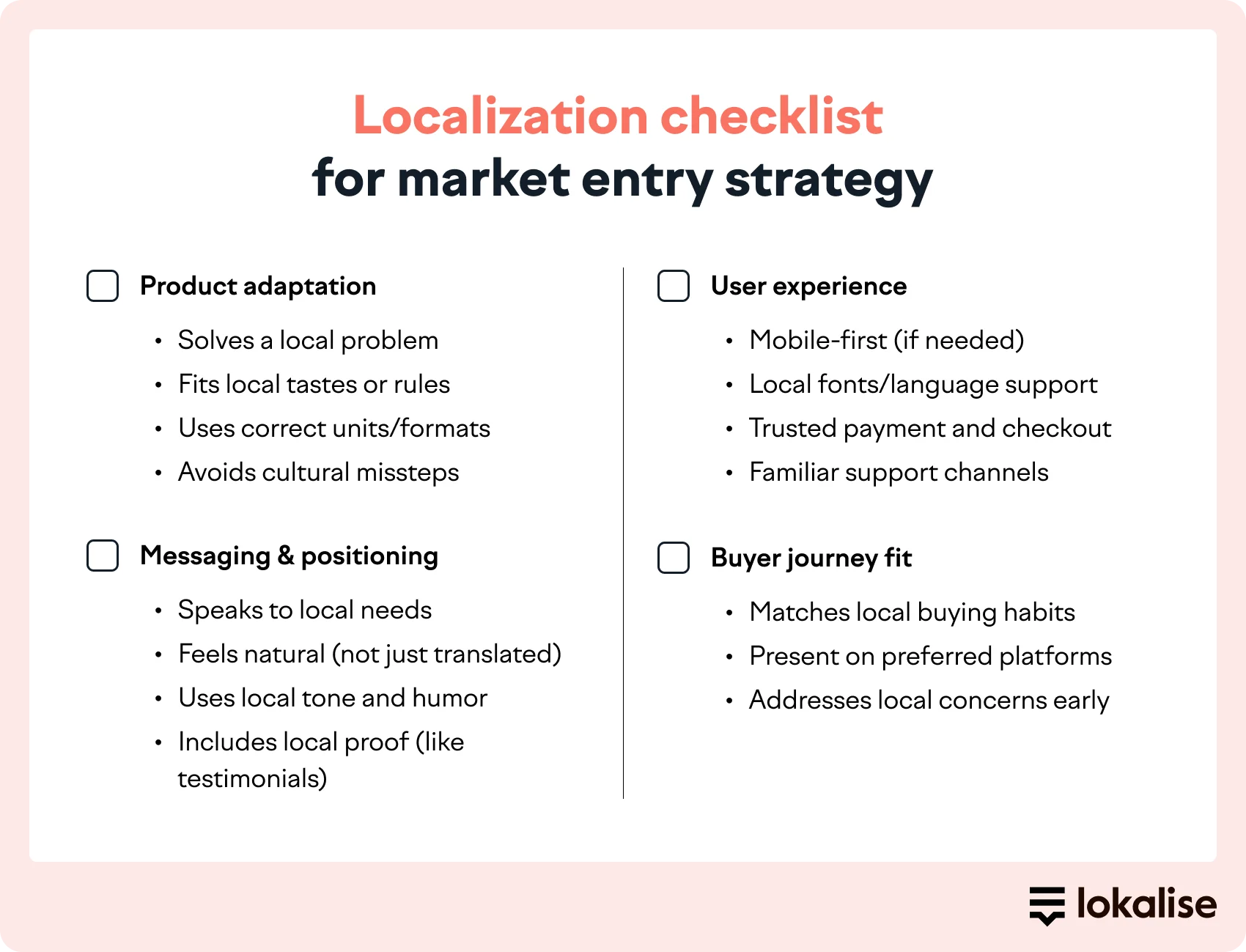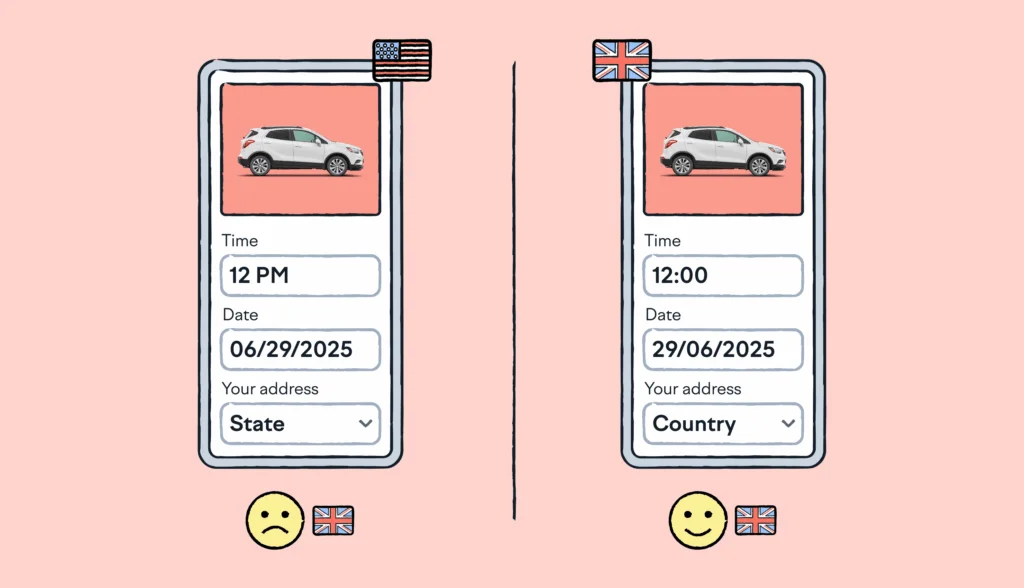Many businesses underestimate the complexity of entering a new market — only to later realize that enthusiasm alone doesn’t translate to success.
That’s why you need a foolproof market entry strategy.
This strategy gives structure to your efforts with clear goals, relevant metrics, well-planned workflows, and timelines. Whether you’re launching in one country or many, a solid new market entry strategy is your best chance at building long-term growth.
In this guide, we’ll give you the tools and tips to build a strategy for expanding into international markets in today’s era of globalization. Plus, we’ll break down real-world examples to show how top brands made it work.
What is a market entry strategy?
A market entry strategy is a detailed plan designed to launch a brand’s products or services in a new market. It defines key tactics to enter the market, one-up the competition, comply with regulations, and connect with local buyers.
6 steps to build an airtight market entry strategy
Unfamiliar customers. Cultural differences. Complex regulations.
Those are just a few challenges you’ll face when expanding into a new market. A market entry strategy prepares the groundwork to tackle these challenges (and more) and set your brand up for long-term success in your target market.
Let’s look at our 6-step framework for building a market entry plan.
1. Set clear goals and guardrails
Before you dig into research and identify which markets you want to enter, hit pause. You have to first define why market expansion is important to your business and what success will look like.
Are you entering a new market to:
- Expand your brand’s footprint
- Explore new revenue streams
- Reduce reliance on a single market
- Test product-market fit in different regions
The goals can be many. However, narrowing in on your objectives will shape your commitment and resource allocation to your market entry strategy.
This goal-setting exercise is also a good place to create boundaries.
Think about how much money you’re willing to spend and set timelines with milestones to see results. Without these guardrails, you’d potentially struggle with internal misalignment, overspending, and sunk-cost thinking.
Here are a few goal-setting templates to document step 1 of your strategy:
| Goal-setting templates | Market entry strategy |
| Our primary objective is to generate $___ in revenue from the [target market] within the first [X months] of launch. To stay within manageable limits, we will cap our total investment at $___ and aim to reach break-even by [insert number] months. For the initial phase, we’ll focus on [entry channel or distribution strategy], which aligns best with our market size, budget, and operational readiness. |
| We want to validate product-market fit by acquiring [X] active users or customers in [target market] and achieving at least a [Y]% retention or satisfaction score within the first [Z months]. We’ll target [specific customer segment] and limit our spend to $___ for this test phase. Our key success metric will be [e.g., Net Promoter Score, conversion rate, or daily engagement], which will help us determine whether to scale or iterate. |
| Our goal is to establish strong brand visibility by achieving [X]% unaided brand recall in [target market] among [target audience segment] within [Y months]. We’ll drive this through [chosen brand channels—e.g., PR, influencer marketing, local activations], and keep our total marketing spend within $___. The timing of the campaign will be aligned with [insert seasonal event, product release, or market milestone] to maximize relevance and impact. |
2. Study the market in depth
Once your vision is locked in, you have to collect market intel.
Instead of repeating your tactics from your domestic market, zoom into your new target markets and find entry points. Focus on actionable insights to find opportunities that your company can capitalize on.
For example, your brand specifically focuses on a buyer segment that local players have ignored.
Here are a few insights you want to explore for finding opportunities:
- What are the gaps in this market?
- Which customer segment is underserved?
- What frustrates customers with current offerings?
- What regulations could block your operations or delay launch?
The success of your new market entry strategy will depend on how well you read the market. Misreading the needs of the market means you end up entering a saturated space where you can’t compete.
So, go beyond existing reports on the market and talk to actual customers through interviews, focus groups, surveys, forums, and more channels.
Map out the differences in buyer journeys and understand the cultural expectations. By the end of this step, you should be ready to identify whether a market is ready for what you’re offering.
3. Choose the best mode of entry
How you enter a market matters just as much as where.
Your mode of entry affects your costs, speeds, legal exposure, and long-term business control. That’s why there’s no one-size-fits-all answer about the right mode for foreign market entry.
Let’s compare all the market entry methods to evaluate before finalizing yours:
| Entry Mode | How it works | Example | Factors to consider |
| Exporting | Selling your product in a foreign market without setting up operations there | A skincare brand in France exports its products to Japan via online orders or local retailers | Low cost, low riskLimited control over customer experienceCan be direct or via a distributor |
| Licensing | Allowing a local company to produce and sell your product under your brand | Disney licenses local toy manufacturers to produce Disney-branded merchandise in different countries | Fast entry, minimal investmentRisk of IP misuseLower margins, less control |
| Franchising | Allowing others to operate a business under your brand using a proven system | McDonald’s uses franchises to expand globally | Scalable and capital-efficientStandardized brand experienceSuccess depends on franchisee quality |
| Partnering (Reseller or Distribution) | Working with a local partner to sell or distribute your product | Shopify partners with local agencies and resellers in Southeast Asia to reach new merchants | Access to local networks and expertiseShared marketing/salesMay dilute brand control |
| Joint Venture | Creating a new entity with a local partner where both parties share ownership | Starbucks initially entered China through a joint venture with Uni-President Group | Shared investment and riskHelps navigate regulation-heavy marketsCan lead to conflicts over decisions |
| Turnkey Project | Setting up operations or systems through direct investment and then handing them over to a local player | Engineering firms build power plants or factories, then transfer ownership to local operators | Common in construction and industrial projectsGood for expertise-driven entryLimited long-term involvement |
| Greenfield Investment | Building operations from scratch in a new country | IKEA’s massive flagship store built in Hyderabad, India | Full control and customizationHigh upfront cost and longer timelineIdeal for long-term market commitment |
To find the ideal mode of entry, score all options across four parameters:
- Risk
- Speed
- Control
- Investment
This would require additional research about local laws, operating costs, and other factors in your target market. By the end of this exercise, you’ll explore all the types of market entry strategies and make an informed decision about the right one for you.
4. Adapt your offer and message
When the initial legwork is complete, get started with localization.
Your brand should feel native to the local market. It should build brand recognition.
That’s why you need a comprehensive localization and marketing translation plan to modify every aspect of your brand — product design, packaging, pricing, and more.
Besides these details, some international markets would also require you to rethink your value propositions entirely. Your value propositions for an Australian audience can’t be the same for a Hispanic one because their priorities and cultures are starkly different.
While localizing your brand, you may also want to consider the buyer journey and preferences.
For instance, buyers in some regions strongly prefer mobile-first experiences, while others still rely heavily on desktop browsing or in-store demos.
Use our checklist for localizing your brand as part of your global marketing strategy:

5. Build the operating backbone
Operations is the Achilles’ heel for most global market entry strategies. This is where your strategy can fall apart because weak execution can break customers’ trust, potentially irreversibly.
Whether you’re a digital-first company or require a physical infrastructure, you need a strong operations setup to expand seamlessly in new, unfamiliar markets. This includes suppliers, logistics, local team, regulatory compliance, and more.
Here are three core operations elements to take care of, especially for brick-and-mortar businesses:
- Supply chain: An efficient supply chain allows you to fulfill orders quickly and maximize customer delight. It also prevents disruptions and stockouts that can lead to a poor customer experience. So, start with a small setup and build relationships with local suppliers. Scale this pipeline once everything looks stable.
- Last-mile delivery: This is the final touchpoint before your product reaches the customer—any delays or poor handling directly impact satisfaction. Work with local courier partners and create micro-warehouses in high-demand areas. You can also offer flexible delivery options.
- Service centers: Make it easy for customers to get support and troubleshoot issues if they face any problems. While it’s difficult to set up multiple physical centers in the beginning, you can offer other channels to connect with support teams, like phone, email, and chat.
Besides this infrastructure, you can partner with third-party service providers to take care of legal and tax compliance in new markets.
6. Craft a go-to-market launch plan
The final step in your international market entry strategy and a crucial part of successful international expansion is to create a go-to-market (GTM) plan.
Your GTM plan will chalk out every detail to create the best first impression of your brand in a local market. This plan will identify a high-potential area or buyer segment to run a controlled launch instead of going all in across the country.
You also have to strategize ways to generate buzz and excitement among local audiences.
Here are a few ways to create a focused GTM strategy and plan:
- Identify a target city or region to pilot your launch
- Create ideal customer profiles (ICP) and tailor your brand positioning for them
- Team up with trusted local partners like influencers, resellers, and community leaders
- Time your launch with local festivals, events, or holidays to ride the wave of excitement
The bottom line? You don’t want to do too many things in too many places.
Start small in one high-demand area and make a solid impression. Then, use PR and marketing campaigns to expand your presence in other places.
Why do businesses need an international market entry strategy
Expanding your business can be daunting, especially since it takes a hefty investment. Without a solid entry strategy, you’re leaving a lot of money at the table.
Here’s what you can gain through a well-planned strategy:
- Maximize savings: A good strategy saves you all the money spent on trial-and-error tactics. So, you only spend on what’s necessary instead of expensive experiments.
- Speed up ROI: Clearly laying out your launch roadmap also fast-tracks your efforts. This can shorten the time it takes to start seeing ROI from new markets.
- Reduce risks: A good strategy covers all fronts, leaving nothing as a surprise for the future. This reduces the chance of last-minute setbacks like legal red tape or cash flow issues.
- Build credibility: Your strategy signals that you’re serious about the market and not just testing it blindly. It creates confidence among investors, vendors, and even potential customers.
Now that we’ve discussed all about market entry strategies, let’s discover a few examples of market entry strategies to inspire yours.
3 real-world examples of different market entry strategies
Wondering how market entry strategies play out in the real world? We’ll look at three businesses that successfully expanded into international markets — and how they did it.
Tony’s Chocolonely
Tony’s Chocolonely is a Dutch chocolate brand well-known for its anti-slavery mission.
The brand entered the US market by partnering with retailers like Walmart and Kroger. This gave Tony’s a platform to be visible among ethically-minded shoppers. Their packaging, storytelling, and product sourcing all reinforced their brand values.
Why it worked
Tony’s Chocolonely differentiated itself in a crowded confectionery market with its mission-driven brand identity. They expanded into markets like the United States, where conscious consumerism is on the rise.
Key takeaways
- Use storytelling to build brand trust quickly
- Lead with values aligned with the local culture
- Lean on local retail distribution instead of building stores
Björk and Berries
Björk and Berries is a Swedish fragrance brand focused on sustainability.
The brand expanded into the UK, France, and other European markets while retaining its Nordic identity. It only tweaked the messaging and packaging to resonate with local cultures. Working with local marketing agencies, the brand planned its campaigns to avoid any cultural blind spots.
Why it worked
Instead of diluting its brand identity, Björk and Berries simply adapted its products’ presentation. The brand retained its authenticity with a strong origin story and appealed to new audiences with customized packaging.
Key takeaways
- Maintain brand DNA while adapting tone and visuals
- Work with local agencies to navigate culture and compliance
- Choose markets that already have a demand for your product category
Galvan London
Galvan London is a fashion brand. They entered the US market by partnering with select wholesale outlets to test market appetite.
Once this proved successful, the brand invested in its e-commerce store and hosted exclusive trunk shows to build a high-touch customer experience. After these efforts paid off, they opened a showroom in New York.
Why it worked
Instead of going all-in from day one, Galvan used a phased strategy to learn, adapt, and scale with confidence. This approach to intentional entry reduced risk while still strengthening reputation.
Key takeaways
- Start with low-commitment channels to experiment, learn, and adapt
- Test demand before committing to building a bigger infrastructure
Break into new markets with confidence and care
With a strong market entry strategy, you can build the foundation for your growth in unfamiliar markets and sidestep costly mistakes that come along the way.
Use this guide to plan your efforts and move with clarity instead of guesswork.
As you complete each step, you’ll discover that localization is the biggest piece of the puzzle. And that’s where Lokalise can give you an edge.
Lokalise is a collaborative platform that helps global teams localize products, websites, and marketing content faster with automated workflows. You can also translate content at scale with Lokalise AI. Give it a try for 14 days to see how it can streamline your market entry strategy.





